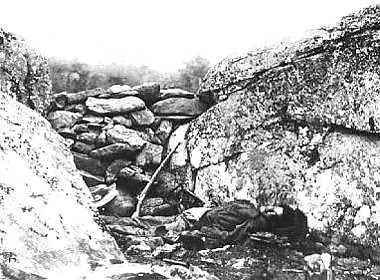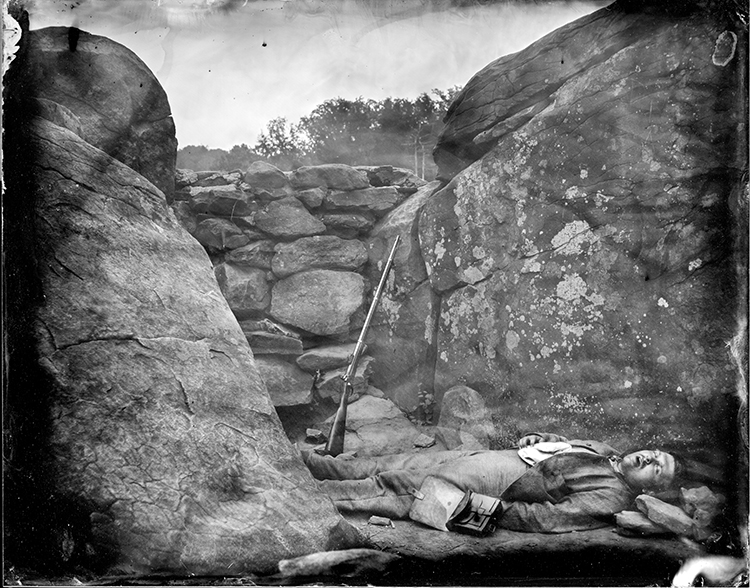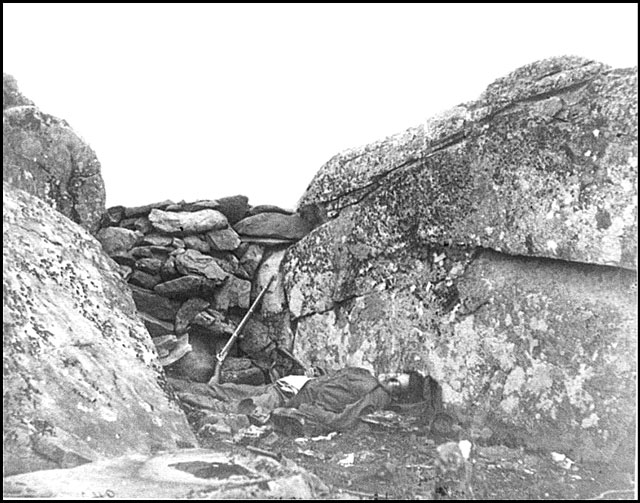|
Civil War Sharpshooters at the Battle of Gettysburg
"Amidst the boulders lay a rebel sharpshooter..."
One of the most widely recognized and often published photographs on the
subject of Gettysburg, this melancholy view of a dead Confederate youth laying behind a stone barricade
at Devil's Den was taken on July 5 or 6, 1863 by photographer Alexander Gardner and two of
associates. Gardner later published the photograph in his "Photographic Sketchbook of the Civil War" accompanied by a lavish
description of his discovery of the dead soldier who he described as a sharpshooter killed at his post. Gardner also speculated
on the dead soldier's final moments in the sniper's nest, adding that he found his bleached bones still lying in the nest
while on a later visit to the site.
| Confederate Sharpshooter at Battle of Gettysburg |

|
| Photograph of a dead Confederate Sharpshooter |
(Right) Dead Confederate "sharpshooter" at Devil's Den,
photographed by Timothy O'Sullivan
on July 6, 1863.
(Library of Congress)
| Civil War Sharpshooter on Picket Duty |

|
| Sharpshooter, Harper's Weekly, November 15, 1862 |
It was not until 1975 when Gettysburg: A Journey In Time by author-historian William Frassanito was published,
that this apparent hoax by Gardner was uncovered. This scene was actually posed by Gardner and his associates who carried
the corpse into this position and dressed up the scene with relics of war scattered about the area. A final touch was the
rifle standing against the barricade, placed by Gardner who had used the weapon in previous photos. Gardner's assistants,
James Gibson and his chief photographer Timothy O'Sullivan, took two photographs of the scene, the clearest of which is shown
here. They then moved on to photograph other scenes in the adjacent "Slaughter Pen", leaving the body in the sharpshooter's
nest.
| "The Home of a Rebel Sharpshooter at Gettysburg" |

|
| Gardner's Photographic Sketchbook of the Civil War, Albumen silver print, 1863 |
Though this scene was contrived by Gardner and his men, it does not detract
from the fact that this young soldier died on a battlefield far away from a home where his relatives and loved ones were possibly
wondering at the very moment this picture was taken, whether he was alive and well or killed in battle. This soldier's identity
has been lost in time, his youthful remains forever preserved in a photographer's image that has haunted historians and the
curious for over a hundred and thirty five years. Yet, the use of his body as a photographer's prop should not detract from
the tragedy of a life snuffed out in battle. The true facts of his death on the rocky slopes of Devil's Den are better known
today, but cannot dim the feeling of loss Americans should feel when we gaze upon this scene and realize that he once had
a name, a family, and a home.
(Related reading below.)
Sources: National Park Service; Gettysburg National Military; Library of
Congress.
Recommended Reading: Sharpshooters of the American Civil War 1861-65.
Description:
When the American Civil War commenced in 1861, both Confederate and Union officials decided that specialized sharpshooter
units should be formed. These highly trained marksmen served in a front-line role and, due to the technological developments
of the 1850s, were equipped with weapons that could guarantee greater accuracy over increased range than traditional muskets.
Continued below...
This title examines the recruitment, training, tactics and deployment of sharpshooters from both sides of
the conflict. It also takes a close look at the specialized weaponry of the sharpshooter, the rifle and its accoutrements,
as well as the sharpshooters' unique insignia and identification patches. It includes full color photos and action-packed
battle scenes.
Recommended Reading: Jack Hinson's
One-Man War, A Civil War Sniper (Hardcover). Description: Jack Hinson never planned to become a deadly
sniper. A prosperous and influential Kentucky plantation
owner in the 1850s, Hinson was devoted to raising his growing family and working his land. Yet by 1865, Hinson had likely
killed more than one hundred men and had single-handedly taken down an armed Union transport in his one-man war against Grant's
army and navy. By the end of the Civil War, the Union had committed infantry and cavalry
from nine regiments and a specially equipped amphibious task force of marines to capture Hinson, who was by that time nearly
sixty years old. They never caught him. Since then, the story of Jack Hinson has evaded astute historians, and until now,
he has remained invisible in the history of sniper warfare. Continued below…
John S. "Old Jack" Hinson watched
the start of the Civil War with impartial disinterest. A friend of Ulysses S. Grant and Confederate officers alike, Hinson
was opposed to secession, focused instead on his personal affairs. After a unit of Union occupation troops moved in on his
land and summarily captured, executed, and placed the decapitated heads of his sons on his gateposts, however, Hinson abandoned
his quiet life for one of revenge. In this unprecedented and incredible biography, Lt. Col. Tom C. McKenney masterfully recounts
Hinson's extraordinary feats as a lone Confederate sniper. Equipped with a rifle he had specially made for long-range accuracy,
Hinson became a deadly gadfly to the occupying army. An exemplary piece of historical scholarship and the result of fifteen
years of research, this definitive biography includes an amazing cast of characters including the Earp Brothers, Nathan Bedford
Forrest, and Jesse James, the cousin of Hinson's wife. This breathtaking story was all but destroyed by the obliterating forces
of history and is the only account in print chronicling this one man's impact on the Civil War.
From the Inside Flap: A quiet,
unassuming, and wealthy plantation owner, Jack Hinson was focused on his family life and seasonal plantings when the Civil
War started to permeate the isolated valleys of the Kentucky-Tennessee border area where he lived. He was uniquely neutral--friend
to both Confederate and Union
generals--and his family exemplified the genteel, educated, gracious, and hardworking qualities highly valued in their society.
By the winter of 1862, the Hinsons' happy way of life would change forever. Jack Hinson's neutrality was shattered the day
Union patrols moved in on his land, captured two of his sons, accused them of being bushwhackers, and executed them on the
roadside. The soldiers furthered the abuse by decapitating the Hinson boys and placing their heads on the gateposts of the
family estate. The Civil War, now literally on Hinson's doorstep, had become painfully personal, and he could remain dispassionate
no longer. He commissioned a special rifle, a heavy-barreled .50-caliber weapon designed for long-range accuracy. He said
goodbye to his family, and he took to the wilderness seeking revenge. Hinson, nearly sixty years of age, alone, and without
formal military training, soon became a deadly threat to the Union. A Confederate sniper,
he made history after single-handedly bringing down an armed Union transport and serving as a scout for Nathan Bedford Forrest.
A tenacious and elusive figure, Hinson likely killed more than one hundred Union soldiers, recording the confirmed deaths
on the barrel of his rifle with precision. Despite the numbers of men sent to kill him, Hinson evaded all capture, and like
his footsteps through the Kentucky and Tennessee
underbrush, his story has been shrouded in silence--until now. The result of fifteen years of research, this remarkable biography
presents the never-before-told history of Jack Hinson, his savage war on his country, and the brutal cost of vengeance and
war.
Recommended Reading:
Shock Troops of the Confederacy (Hardcover: 432 pages). Description: Fred Ray's Shock Troops of the Confederacy is primarily
focused on the "sharpshooter battalions" of the Army of Northern Virginia. In a Civil War context, "sharpshooter" was usually
more akin to "skirmisher" than "sniper," although these specialized battalions also used innovative open order assault techniques,
especially late in the war. Continued below...
Ray
includes, however, a detailed study of Union sharpshooter battalions and Confederate sharpshooters in the West. Remarkably,
little has been published about such organizations in the past, so Fred Ray's book offers a unique study of the evolution
of Civil War infantry tactics, revealing a more complex, sophisticated approach to the battlefield than is usually understood.
Recommended
Reading:
U.S. Sharpshooters:
Berdan's Civil War Elite (Hardcover). Description: This detailed and beautifully illustrated book tells
the story of Col. Hiram Berdan’s brilliant conception: the U.S. Sharpshooters, a specialized 2-regiment unit of marksmen
recruited from the farming and backwoods communities of the North. Known for their distinctive green uniforms, Sharps breech-loading
rifles, and risky tactics, the Sharpshooters fought at battles such as the Peninsula, Chancellorsville, Gettysburg, and the Wilderness. Continued below...
The book covers their training,
tactics, and weapons and is a must-have for Civil War enthusiasts and anyone interested in the history of special forces.
Features paintings by acclaimed Civil War artist Don Troiani. About the Author: Roy Marcot has written several books, including
Remington: America s Oldest Gunmaker, The History of Remington Firearms, and Hiram Berdan:
Chief of Sharpshooters. He is a member of the American Society of Arms Collectors.
Recommended Reading: Sniper:
A History of the US Marksman (General Military) (Hardcover: 304 pages) (Osprey Publishing: August 21, 2007). Description
- Reviews: "Martin Pegler's Sniper is an engrossing history of U.S. military snipers spanning more than two hundreds
years. This careful assessment of the rationale behind and the motivation that drives snipers dispels the idea that snipers
are no more than assassins. Instead Pegler shows how snipers are all about protection, and their main job is to protect their
fellow squad members." -Dan Danbom, TimeOut for Entertainment (October/November 2007). Continued below...
"... Sniper is more than a survey of modern military strategy; it covers military marksmanship history in
America from Revolutionary War days to modern times, considering the first usage of marksmen and their strategic evolution.
Chapters chronicle over 200 years of sniper history and developments, from training to weaponry, and make for
an excellent addition to any military library." -The Bookwatch (October 2007)
Recommended Reading: Rebel Private: Front and Rear: Memoirs of a Confederate Soldier. Description:
First published in 1907, the memoirs of a former Confederate soldier who fought at Gettysburg, Chancellorsville, Second Manassas, and Chickamauga
reveal the ground-level perspective of a Civil War private. Continued below…
From Publishers Weekly:
William Fletcher joined the Confederate Army in 1861. He served with the Army of Northern Virginia's elite Texas Brigade until
the Battle of Chickamauga. Unable to march because of wounds, he transferred to the cavalry and finished the war with the
Texas Rangers, then wrote his memoirs 40 years later. Most of the original copies were destroyed in a fire. The current edition
presents unvarnished images of hard marches, short rations and battles in which being wounded could prove worse than being
killed. Fletcher describes the horrors of being a Civil War casualty as vividly as any firsthand account from either side.
The author emerges from these pages as fighting less for a cause than for his own pride in being a good soldier. His narrative
does more than many learned monographs to explain the Confederacy's long endurance against overwhelming odds.
Recommended Reading:
Lee's Sharpshooters (Hardcover) (496 pages)
Try the Search Engine for Related
Studies: Civil War Sharpshooters at Devil's Den and Slaughter Pen during the Battle of Gettysburg, Confederate
Sharpshooter Units: Types of Firearms, Rifles, Muskets and Guns, Rebel Sharpshooters, General Lee, General Lee's Tactics and
Strategy, Union and Confederate Sharpshooter Battles
|

